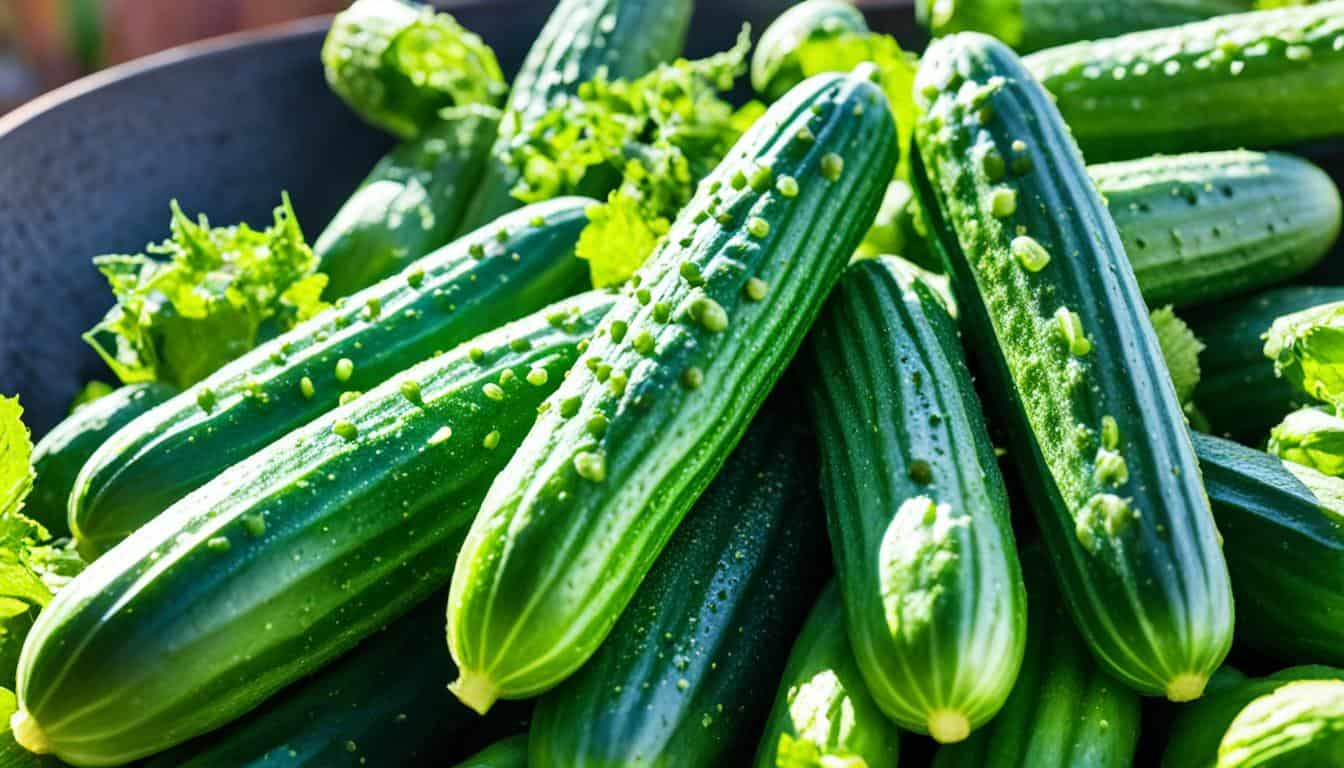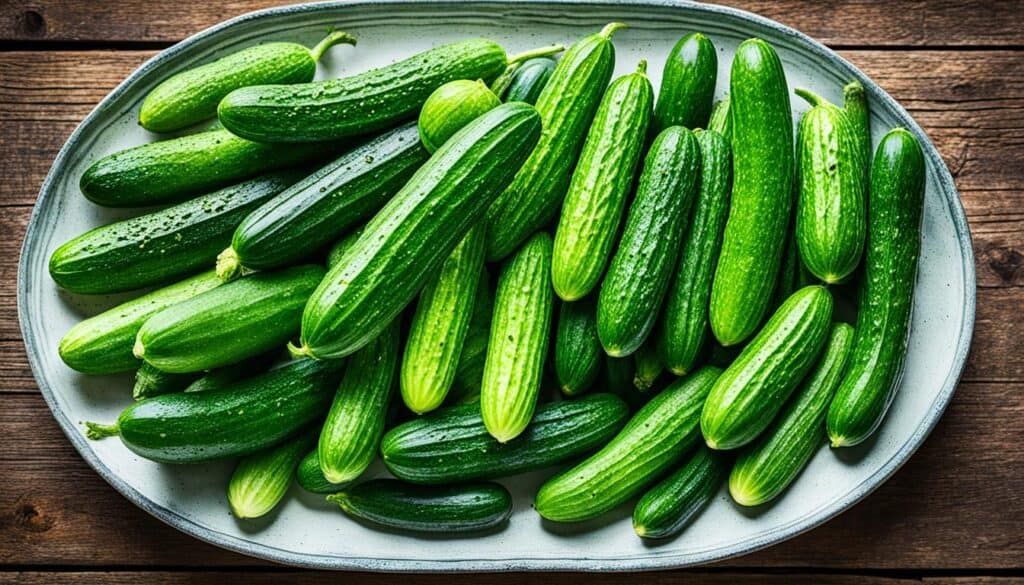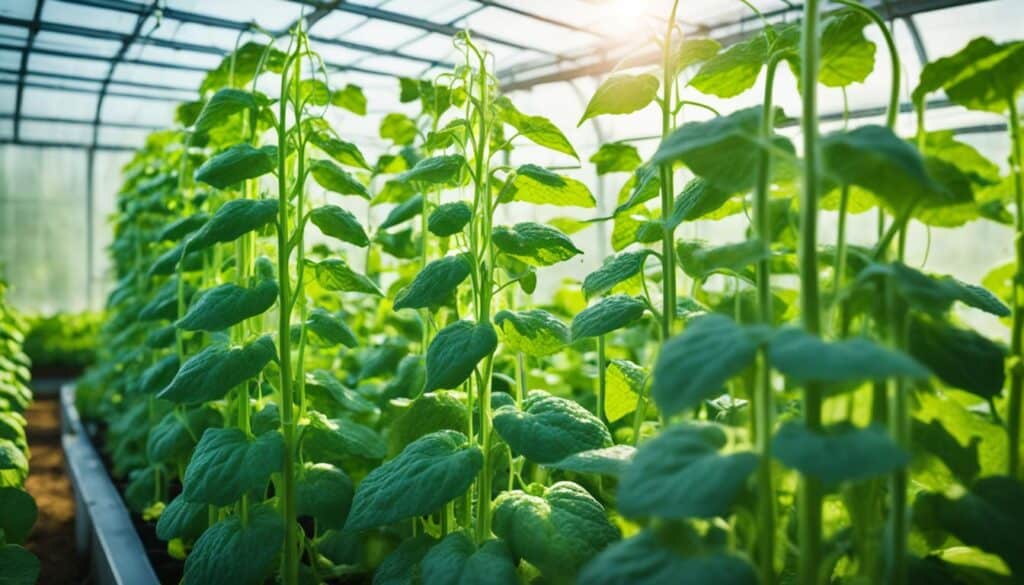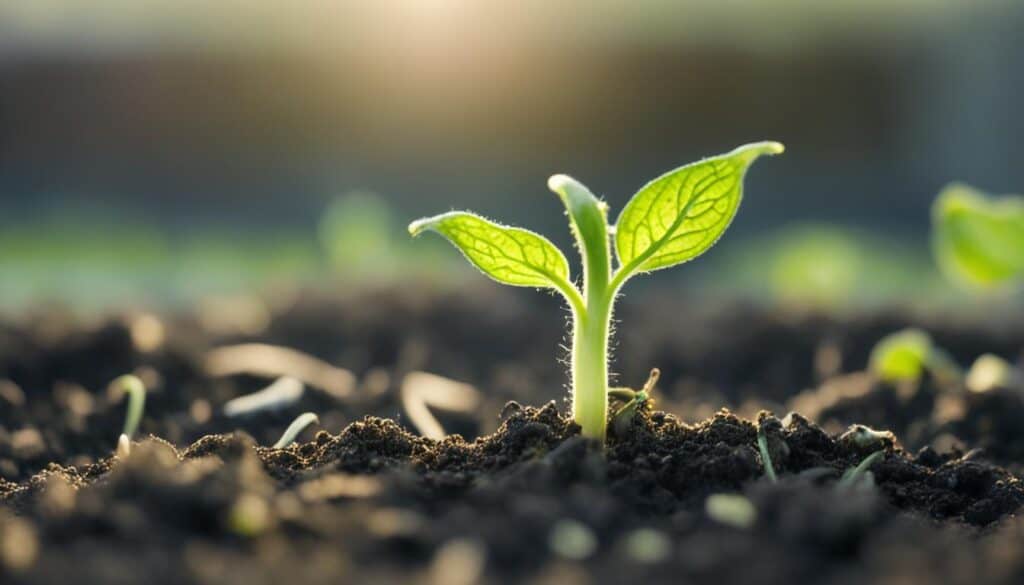Did you know that there are over 100 different cucumber varieties available for your gardening pleasure? From the classic slicing cucumbers to unique and visually appealing varieties, cucumbers offer a world of possibilities in your garden. Whether you’re searching for the best tasting cucumbers, disease-resistant options, or varieties suitable for pickling or greenhouse cultivation, there’s a cucumber variety out there that will meet your needs.
Join me as we dive into the fascinating world of cucumber varieties and discover the top picks for flavor, yield, and versatility. Whether you’re a seasoned gardener or just starting out, this guide will help you make informed choices and take your cucumber-growing game to the next level.
Key Takeaways:
- There are over 100 different cucumber varieties available for your garden.
- Cucumber varieties offer a wide range of flavors, shapes, and colors.
- Choose cucumber varieties based on your gardening needs, such as fresh eating, pickling, or greenhouse cultivation.
- Disease-resistant and high-yielding cucumber varieties can ensure a successful harvest.
- Experiment with different cucumber varieties each season to explore new flavors and enhance your gardening experience.
Slicing Cucumbers: Fresh Off the Vine Delight
Slicing cucumbers are a delightful addition to any meal, perfect for enjoying fresh off the vine in salads, sandwiches, or simply as a refreshing snack. When it comes to slicing cucumbers, there are several standout varieties that offer exceptional flavor, texture, and versatility.
1. Straight Eight
The Straight Eight cucumber variety is a classic choice for slicing. True to its name, this cucumber consistently grows to a straight, cylindrical shape, making it easy to slice evenly. The Straight Eight offers a mild and crisp flavor, making it a favorite for fresh eating.
2. Marketmore 76
Another exceptional slicing cucumber is the Marketmore 76. This variety is renowned for its excellent quality and impressive yield potential. It produces long, dark green cucumbers with a slightly bumpy texture. Marketmore 76 is also known for its resistance to common cucumber diseases, ensuring a healthy harvest.
3. Ashley
Ashley cucumbers thrive in warmer climates and are an excellent choice for slicing. This variety boasts a smooth and straight shape, making it easy to cut into uniform slices. Ashley cucumbers are not only delicious but also resilient against mildew and downy mildew, making them a reliable choice for your garden.
For a visual representation of these top slicing cucumber varieties, refer to the table below:
| Cucumber Variety | Size | Flavor | Disease Resistance |
|---|---|---|---|
| Straight Eight | Medium to large | Mild | Resistant |
| Marketmore 76 | Long | Crisp | Resistant |
| Ashley | Medium to large | Delicious | Resilient |
Prepare your garden for a bountiful cucumber harvest by choosing slicing cucumber varieties that best meet your preferences and growing conditions. Whether it’s the consistent size and shape of the Straight Eight, the excellent quality and disease resistance of Marketmore 76, or the delicious resilience of Ashley cucumbers, slicing cucumbers are sure to bring delight to your fresh salads, sandwiches, and snacks.
Pickling Cucumbers: Preserving Summer’s Crunch
Pickling cucumbers offer the perfect crunch and texture to elevate your homemade pickles. These cucumbers are smaller in size and have a thicker, bumpier skin compared to other varieties. This unique combination makes them ideal for pickling, as their firmness holds up well during the pickling process. If you’re eager to embark on a pickling adventure, consider these top pickling cucumber varieties to ensure delicious results:
Boston Pickling
Boston Pickling cucumbers are a beloved heirloom variety that has been used for generations for its exceptional pickling qualities. These cucumbers are known for their short, blocky shape and distinct green hue. When pickled, they retain their crispness and deliver a classic, tangy flavor that pairs perfectly with sandwiches, burgers, and charcuterie boards. With their traditional appearance and superb taste, Boston Pickling cucumbers are an excellent choice for any pickling enthusiast.
H-19 Little Leaf
H-19 Little Leaf cucumbers are highly regarded for their disease resistance and compact growth habit. Despite their smaller stature, these plants produce full-sized cucumbers that are ideal for pickling. The H-19 Little Leaf variety boasts excellent disease resistance, making it less susceptible to common cucumber diseases. This disease resistance enables gardeners to enjoy a bountiful harvest of crisp, flavorful pickles without the worry of plant health. Whether you have limited gardening space or simply want a reliable pickling cucumber variety, H-19 Little Leaf is the perfect choice.
Both Boston Pickling and H-19 Little Leaf cucumbers bring their unique attributes to the pickling process, resulting in pickles that burst with flavor and maintain their crunch. Whether you’re a seasoned pickler or a beginner, these varieties will inspire you to experiment with different flavors and spices to create your signature pickles.
| Pickling Cucumber Variety | Description |
|---|---|
| Boston Pickling | Heirloom variety with a short, blocky shape and distinct green hue. Exceptional pickling qualities and tangy flavor. |
| H-19 Little Leaf | Disease-resistant variety with a compact plant. Produces full-sized cucumbers ideal for pickling. |
When it comes to pickling cucumbers, Boston Pickling and H-19 Little Leaf are top choices that will elevate your pickle-making game. Their robust flavors and crisp textures ensure delicious pickles that preserve the essence of summer’s bounty. Pickling cucumbers are not only a practical way to enjoy fresh cucumbers throughout the year but also a delightful addition to any meal or snack.
Best of Both Worlds: Versatility at Its Finest
Some cucumber varieties offer versatility, excelling in both fresh eating and pickling. One such versatile cucumber variety is Pioneer.
Pioneer is a modern cucumber variety that is known for its exceptional dual-use capability. Its thin skin makes it enjoyable fresh, while also pickling exceptionally well. Whether you prefer a crisp cucumber salad or tangy homemade pickles, Pioneer delivers on both fronts.
| Variety | Use | Key Features |
|---|---|---|
| Pioneer | Fresh Eating and Pickling |
|
“Pioneer is truly a game-changer in the cucumber world,” says gardening enthusiast, Rebecca Martinez. “I love that I can enjoy the same cucumber variety in different ways. Whether I want a refreshing snack or a jar of crispy pickles, Pioneer never disappoints.”
With its combination of versatility, reliability, excellent yield, and resistance to common cucumber diseases, Pioneer is an excellent choice for home gardeners who want both flexibility and performance in their cucumber plants.
Greenhouse Growing: Optimized for Sheltered Cultivation
When it comes to cucumber cultivation, greenhouse growing offers a plethora of advantages. By providing a controlled environment, greenhouses extend the growing season, protect plants from extreme weather conditions, and enable gardeners to optimize the cultivation process. In particular, greenhouse cucumbers thrive in the sheltered environment, producing healthier and more prolific plants.
One popular greenhouse cucumber variety is Beit Alpha. With its delightful flavor, thin skin, and parthenocarpic nature, Beit Alpha has gained significant recognition among greenhouse growers. Parthenocarpic simply means that the fruits develop without pollination, resulting in seedless cucumbers. This characteristic not only facilitates cultivation but also guarantees consistent and bountiful yields.
But it’s not just about convenience; Beit Alpha cucumbers are also known for their exceptional taste. They offer a crisp and refreshing bite, making them a favorite among cucumber enthusiasts. Whether you plan to enjoy them in salads, sandwiches, or as a snack, Beit Alpha cucumbers are sure to please your taste buds.
If you’re considering greenhouse cultivation, be sure to add Beit Alpha cucumber seeds to your gardening roster. Their versatility and reliability make them an excellent choice for both amateur and experienced greenhouse growers.
Comparing Greenhouse Cucumbers
| Cucumber Variety | Advantages | Disadvantages |
|---|---|---|
| Beit Alpha | Delightful flavor, thin skin, parthenocarpic nature | May require trellising due to vine size |
| Other Greenhouse Cucumber Variety 1 | Advantage 1 | Disadvantage 1 |
| Other Greenhouse Cucumber Variety 2 | Advantage 2 | Disadvantage 2 |
Container Gardening: Perfect Picks for Limited Space
For gardeners with limited space, certain cucumber varieties excel in container gardening settings. These compact cucumber varieties are perfect for pots and small garden spaces, allowing you to enjoy a bountiful yield of flavorful fruit.
Spacemaster
Spacemaster is an excellent choice for container gardening cucumbers. This variety is specifically bred to thrive in confined spaces while still producing abundant cucumbers. Its compact size makes it ideal for smaller containers, making the most of limited space. Despite its smaller stature, Spacemaster delivers full-sized cucumbers with outstanding flavor, perfect for fresh eating and pickling.
Lemon
If you’re looking to add a touch of whimsy to your container garden, consider planting Lemon cucumbers. These charming cucumbers feature petite, round, pale yellow fruit that resembles small lemons, hence their name. Lemon cucumbers have manageable vines, making them an excellent choice for containers. Their mild, sweet flavor pairs well with salads and is a delightful addition to any dish.
By choosing Spacemaster and Lemon cucumbers for your container garden, you can maximize your unique gardening conditions and enjoy a fruitful harvest.
| Cucumber Variety | Size | Yield | Flavor |
|---|---|---|---|
| Spacemaster | Compact | Bountiful | Outstanding |
| Lemon | Petite | Satisfactory | Mild and Sweet |
Creating Intrigue in the Garden: Unique Cucumbers to Spark Conversations
Adding unique cucumber varieties to your garden can create visual interest and spark conversations. These extraordinary cucumbers provide a delightful twist on the traditional cucumber, captivating both the eyes and taste buds of your garden visitors.
Armenian Cucumbers: Snake Melons with a Mild Sweetness
Armenian cucumbers, also known as snake melons, are a fascinating addition to any garden. With their distinctive pale green, ribbed skin, and elongated shape, they instantly stand out in a sea of green. Despite their resemblance to melons, Armenian cucumbers are indeed cucumbers with a mildly sweet flavor. Their crisp texture and delicate taste make them perfect for slicing raw in salads or sandwiches.
White Wonder Cucumbers: Delicate and Refreshing
If you’re looking to add elegance and sophistication to your garden, consider growing White Wonder cucumbers. These unique cucumbers boast an ivory skin, creating a stunning contrast against the vibrant greens in your garden. When it comes to taste, White Wonder cucumbers offer a delicate and refreshing flavor. Their thin skin and tender flesh make them enjoyable both raw and pickled, offering versatility in your culinary endeavors.
By cultivating Armenian and White Wonder cucumbers, you’ll not only enhance the aesthetic appeal of your garden but also provide a unique and memorable experience for your visitors.
How to Grow Cucumber
Growing cucumbers can be a rewarding experience, whether you are a seasoned gardener or just starting out. To ensure a successful cucumber harvest, it is essential to pay attention to key cultivation practices, such as soil preparation, planting and spacing, mulching, irrigation, and fertilization. By following these guidelines and choosing the right cucumber varieties for your growing conditions, you’ll be on your way to enjoying delicious and fresh cucumbers straight from your garden.
Soil Preparation
The first step in growing cucumbers is to prepare the soil. Cucumbers thrive in well-drained, fertile soil that is rich in organic matter. Before planting, loosen the soil to a depth of at least 12 inches and remove any weeds or debris. Incorporate compost or well-rotted manure to improve the soil’s nutrient content and moisture-retaining capacity. Aim for a slightly acidic to neutral pH level between 6.0 and 7.0 for optimal cucumber growth.
Planting and Spacing
When it comes to planting cucumber seeds or seedlings, timing is crucial. Cucumbers are warm-season crops, so wait until all danger of frost has passed and the soil temperature reaches at least 60°F (15°C) before planting. Sow the seeds or transplant the seedlings directly into the garden or containers, following the spacing recommendations provided by the seed packet or nursery. Proper spacing allows for good air circulation and helps prevent the spread of diseases.
Mulch
Mulching is an effective method to control weeds, conserve soil moisture, and maintain a consistent soil temperature for cucumber plants. Apply a layer of organic mulch, such as straw or shredded leaves, around the base of the plants. This helps to suppress weed growth and retain moisture in the soil, reducing the need for frequent watering. Additionally, mulching protects the developing cucumbers from direct contact with the soil, which can prevent rotting and disease.
Irrigation
Cucumbers have high water requirements, especially during hot and dry periods. Consistent and adequate irrigation is essential for proper growth and fruit development. Water the plants deeply, aiming for at least 1 inch of water per week, either through rainfall or manual watering. Avoid overhead watering, as it can promote the spread of fungal diseases. Instead, use a soaker hose or drip irrigation system to provide water directly to the soil, keeping the leaves dry.
Fertilizer
Proper fertilization is crucial to ensure healthy cucumber plants and high yields. Before planting, incorporate a balanced fertilizer, such as a 10-10-10 or 14-14-14, into the soil according to the package instructions. Once the plants start producing fruits, side-dress them with a nitrogen-rich fertilizer, such as blood meal or compost, to promote vigorous growth and fruit development. Always follow the recommended rates and frequency of application provided on the fertilizer label.
| Aspect of Cucumber Cultivation | Key Considerations |
|---|---|
| Soil Preparation | Loosen the soil, remove weeds, and incorporate organic matter to improve fertility and drainage. |
| Planting and Spacing | Plant cucumber seeds or seedlings at the right time and space them adequately for good air circulation. |
| Mulch | Apply organic mulch around the plants to suppress weeds, retain moisture, and protect developing cucumbers. |
| Irrigation | Provide consistent and deep watering to meet cucumber’s high water requirements, using soaker hoses or drip irrigation systems. |
| Fertilizer | Incorporate balanced fertilizer before planting and side-dress with nitrogen-rich fertilizer during fruit production. |
Conclusion
Growing a variety of cucumber types in your garden can be a rewarding experience. With their refreshing taste and versatility, cucumbers are not only a delicious addition to your meals but also a fun way to add intrigue to your garden. By selecting the best cucumber varieties for your needs and following proper cultivation techniques, you can enjoy a bountiful harvest of cucumbers.
To start growing cucumbers, choose from the wide range of cucumber varieties available, including slicing cucumbers like Straight Eight and Marketmore 76, pickling cucumbers like Boston Pickling and H-19 Little Leaf, and versatile cucumbers like Pioneer. Consider your specific gardening needs, such as greenhouse cultivation or container gardening, and choose cucumber varieties like Beit Alpha for greenhouses or Spacemaster for limited spaces.
When growing cucumbers, ensure they receive plenty of sunlight and plant them in well-drained, fertile soil. Prepare the soil properly, space the plants accordingly, and provide them with mulch, adequate irrigation, and the right fertilization. These garden tips will help you achieve healthy cucumber plants and optimize your harvest.
So, why not experiment with different cucumber varieties each season to discover new favorites and enhance your gardening experience? With the right cucumber varieties, proper cultivation techniques, and a bit of curiosity, you can enjoy a continuous supply of fresh cucumbers for eating, pickling, and adding a touch of green to your garden.










Leave a Reply